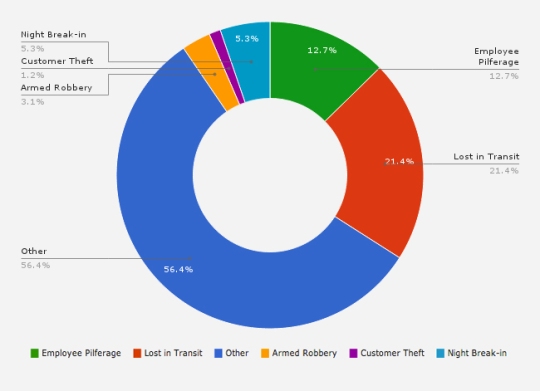Widespread Problem
Between January and August 2013, there were 13,885 instances of drug theft reported by hospitals, pharmacies, EMS agencies, and other health care organizations in the United
States. These 13,885 instances translated into almost 10 million individual units being stolen. A large portion of these reported incidents are categorized as “Employee Pilferage” and “Lost in Transit.”

Effect on Agencies
It is no secret that controlled substance diversion is a growing epidemic. It seems that every time you turn on the news you hear about narcotics theft within an EMS agency. The consistent occurrences of reported theft paired with the increased media coverage have caused the DEA to pass strict mandates on controlled substance storage. The pressure being applied by the general public has caused the DEA to hastily release mandates that incorporate vague language. This has left EMS agencies in a challenging position as they struggle to interpret and comply with new requirements. As controlled substances theft becomes a more prominent issue, the penalties EMS agencies face if they violate new requirements can be severe. Non-compliant agencies can:
- Be limited on dispensing certain controlled substances en route to local hospitals
- Face fines
- Have their registration suspended
- Be subjected to multiple investigations
- Take a huge hit to their integrity
- Be put under a microscope to prevent further violations
Be Proactive, Minimize Risk
With all the ramifications that are associated with violating these mandates, strong policies on safeguarding, securing and accounting for all controlled substances stored and used are an absolute must. The traditional methods no longer suffice. Implementing an effective plan or system will reduce the risk of controlled substance theft. It is important to understand that there is never going to be a foolproof strategy that will completely eliminate the threat of narcotics theft. However, this should not stop agencies from implementing a solution that minimizes risk. One effective solution is using controlled substance storage units (i.e. lockers, lock boxes) equipped with access control capabilities. These units immediately increase security and provide access monitoring. There are multiple options available that all have different benefits. When researching these possible options, consider the following factors:
- What is my budget?
- How secure do I want it?
- Will it be easy for agents to use?
- Can system scale and be easily implemented in multiple EMS vehicles?
- Is there enough room on ambulances to install system?
On top of asking these questions, it is important to get everyone in the agency to be on board and buy into the solution. You don’t want to invest in something that isn’t going to be used properly. So when making a decision, it would not hurt to get feedback and opinions of coworkers.
Affordable Alternative
Many of the options available in today’s market are expensive and require heavy installation. Unfortunately, many EMS organizations are volunteer or simply do not have the funds available to incorporate a $15,000-$20,000 security system for controlled substances. Even lacking available funds, these agencies are still held to the same standards as for-profit EMS organizations. So they are tasked with the difficulty of finding a balance between affordability and reliability when searching for a system. Enter NarcLock. NarcLock is gaining traction within the EMS community as an affordable and secure option. It is a wireless security system that allows agencies to monitor and control access to controlled substances. The wireless feature gives EMS agencies the flexibility to implement NarcLock system in ambulances, lock boxes, containers, filing cabinets, medicine storage compartments, and other sensitive areas. Some of the benefits include:
- Fraction of the cost of similar systems
- Easily retrofit system using your existing lock hardware
- No bulky equipment, minimizing the amount of space needed to install
- Electronic audit reports detailing access attempts to controlled substances
- Control access by granting access to individual agents during specific schedules
- No wiring or power needed for operation so system works during power outages
Whether or not NarcLock is the right choice, EMS agencies must plan ahead and have a strategy in place regulating how controlled substances are stored and who handles them, as well as required documentation of access activity.
Contact us today to learn more about our wide range of narcotics storage solutions.


